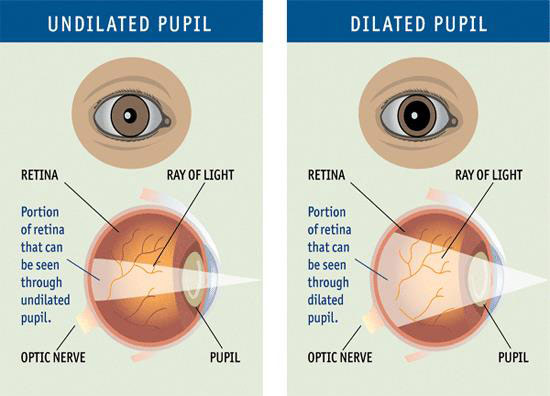
Dilated Eye Exam – Why You Need One
A comprehensive eye exam consists of two parts: the undilated section of the exam and the dilated section. While the undilated eye exam looks at the front part of the eye (pupils, iris, and cornea), the dilated exam goes a bit further to reveal the status of the inner part of the eye, which is comprised of the retina and the optic nerve. The main difference between the two exams is that in order to see through the inner part of the eye, the doctor must use special eye drops to dilate the pupil.
At Beach Eye Medical Group, with locations in Irvine and Huntington Beach, CA, comprehensive eye exams are performed on a daily basis. Our highly trained eye experts aim to identify at-risk patients by performing both undilated and dilated exams, which enables them to provide patients with key recommendations to prevent further vision degradation.
Who should have a dilated eye exam?
People aged 60 and above. According to the National Eye Institute, all persons above 60 years old should undergo a comprehensive eye exam at least once a year.
Diabetics. Diabetic Retinopathy is defined as a complication of diabetes, caused by uncontrolled blood sugar levels. Once diagnosed, people with diabetes should get their eyes checked by having a comprehensive eye exam at least once a year to prevent vision loss.
African Americans. Due to a higher risk of developing glaucoma, African Americans are encouraged to start scheduling an annual comprehensive eye exam at the age of 40.
What conditions can be diagnosed with the dilated eye exam?
A thorough dilated eye exam performed by one of our eye care professionals at Beach Eye Medical Group in Irvine and Huntington Beach, CA, can provide a diagnosis for the following eye/vision problems in their early stages:
- Glaucoma
- Macular Degeneration
- Retinal Tear/Detachment
- Ocular Tumors
How is a dilated eye exam performed?
- Special eye drops are used to dilate the pupil and see the inner part of the eye. A dilated pupil means more light can come through the eye and enable the visualization of the macula, retina and optic nerve.
- Tonometry is used to test the eye’s pressure and test for Glaucoma.
- A visual field test is done to measures a patient’s peripheral vision.
- A visual acuity test is performed to measure a patient’s ability to see at various distances.
While a regular eye exam may be sufficient for young, healthy individuals, a dilated eye exam is essential for a certain high-risk population in order to prevent the onset of and worsening of various eye ailments.
Your eyes are an important part of your body, so be sure to take care of them. A dilated eye exam is a fairly easy way to get an idea of how your eyes are faring against disease and aging. Make an appointment with the Beach Eye Medical Group at either our Irvine or Huntington Beach location. Speak with a member of our team who would be happy to help you with any questions.




